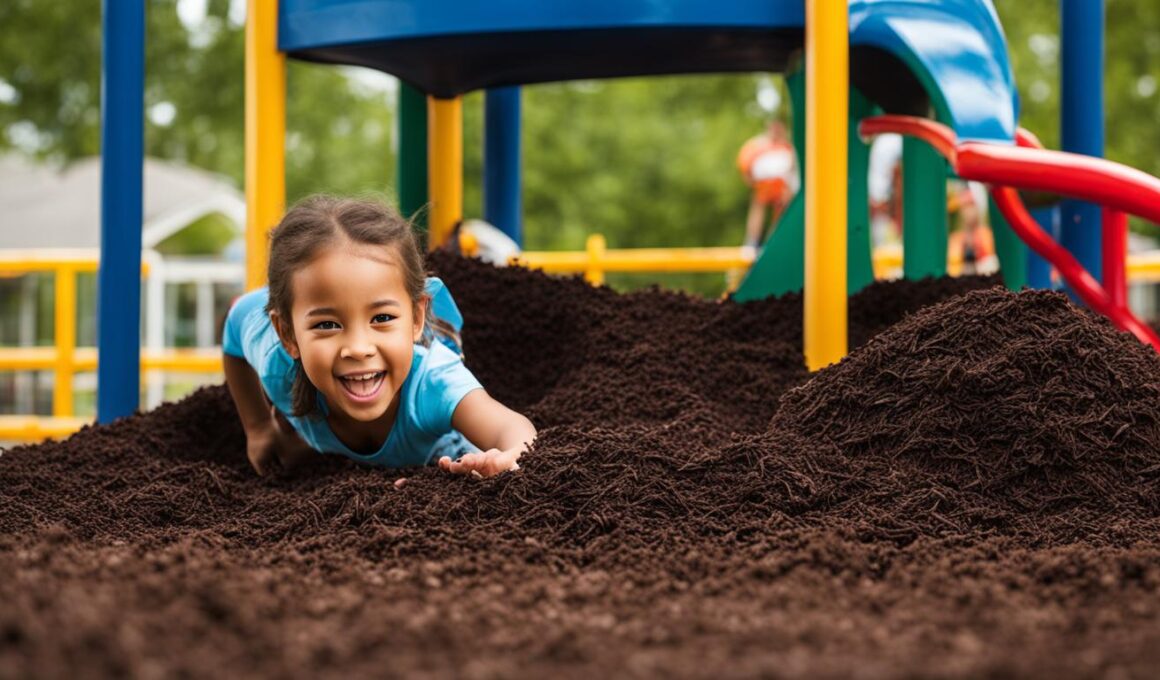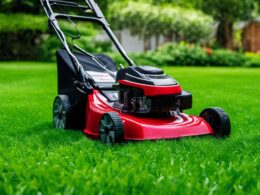Rubber mulch has gained popularity in recent years for its long-lasting properties and low maintenance requirements. However, concerns have been raised about the safety of this type of mulch and the potential impact it may have on soil health and plant growth. To determine whether rubber mulch is safe for your garden and play areas, it is important to delve into the truth behind its advantages and disadvantages.
Key Takeaways:
- Rubber mulch provides insulation, weed control, and pest resistance.
- It has long-lasting durability and does not fade or decompose.
- Rubber mulch can potentially contaminate soil with chemicals and heavy metals.
- It may release volatile organic compounds (VOCs) and pose fire hazards.
- Exposure to rubber mulch can have toxicity risks and health concerns.
Benefits and Drawbacks of Rubber Mulch
Rubber mulch offers various benefits that make it a popular choice for landscaping. One of its advantages is its low maintenance requirements. Unlike organic mulch, rubber mulch does not decompose or fade, lasting for several years. It stays in place, which means you won’t have to deal with mulch spreading or blowing away.
Additionally, rubber mulch provides insulation for plant roots, helping to regulate soil temperature and protect plants from extreme weather conditions. This insulation property is especially beneficial in regions with hot summers or cold winters.
Another advantage of rubber mulch is its pest resistance. Unlike wood mulch, rubber mulch is not attractive to insects, reducing the risk of infestations. This can help maintain the health and vitality of your plants.
However, it’s important to consider the drawbacks when using rubber mulch. One significant drawback is the higher cost compared to organic mulch options. Rubber mulch tends to be more expensive upfront, which can impact the overall budget for your landscaping project.
Another potential downside is the risk of soil contamination. Rubber mulch is made from recycled tires, which can contain chemicals and heavy metals. Over time, these substances may leach into the soil, potentially affecting plant health and contaminating groundwater.
Despite these drawbacks, rubber mulch remains a popular choice for its durability, insulation, and pest resistance. However, it’s essential to weigh the pros and cons before incorporating it into your landscaping plans.
Weed Control with Rubber Mulch
Rubber mulch is a popular choice for gardeners looking to control weed growth effectively. The use of rubber mulch helps to suppress the growth of weeds, keeping your garden or landscape looking clean and well-maintained. However, it’s important to note that while rubber mulch can be effective in the short term, organic mulches may provide better long-term weed control.
To prevent weeds, it is recommended to apply a layer of rubber mulch that is at least 2 inches thick. For optimum weed control, consider using a layer that is 4 inches thick. The thickness of the rubber mulch layer acts as a barrier, preventing sunlight from reaching weed seeds and preventing their germination. This helps to reduce weed growth and minimize the need for manual weeding.
It’s important to understand that rubber mulch does not prevent the germination of existing weed seeds in the soil. Therefore, it is crucial to weed or till the soil thoroughly before applying rubber mulch. This will help to remove any existing weed seeds, allowing the rubber mulch to perform more effectively in controlling weed growth.
Benefits of Weed Control with Rubber Mulch:
- Suppresses weed growth effectively
- Reduces the need for manual weeding
- Maintains a clean and well-maintained appearance
Drawbacks of Weed Control with Rubber Mulch:
- Potential for existing weed seeds to germinate
- May not provide long-term weed control compared to organic mulches
When considering weed control options for your garden or landscape, it’s important to weigh the benefits and drawbacks of rubber mulch. While it can be effective in controlling weed growth, it’s also essential to take into account the long-term maintenance and potential limitations. Exploring alternative mulching options may provide a sustainable solution for weed control while considering the specific needs of your garden.
Safety of Rubber Mulch in Play Areas
Rubber mulch is a popular choice for play areas due to its excellent shock absorption properties. It provides a soft landing surface that helps reduce the risk of injuries from falls, making it ideal for children’s play spaces.
One of the advantages of rubber mulch is that it stays in place, unlike traditional mulch materials that can scatter or shift easily. This means that the play area remains clean and tidy, eliminating the need for constant maintenance.
When using rubber mulch in play areas, it is essential to choose wire-free options. Sharp wires can sometimes be found hidden within recycled rubber materials, which can pose potential injury risks. Always ensure that the rubber mulch you use has been properly processed and screened to remove any potential hazards.
To provide optimal safety, it is recommended to maintain a minimum depth of 6 inches of rubber mulch in play areas. This depth helps ensure effective shock absorption, reducing the impact of falls and providing a cushioned landing surface.
Consider the image below, which depicts a vibrant and safe play area covered with rubber mulch:
Environmental Concerns and Contamination Risks
When considering the use of rubber mulch, it is essential to understand the potential environmental concerns and contamination risks associated with this popular landscaping material.
Rubber mulch is made from recycled tires, which contain chemicals and metals that have the potential to contaminate the soil and groundwater. These contaminants, such as zinc, can have detrimental effects on plant growth, particularly in areas with zinc-rich soil.
Additionally, rubber mulch can release volatile organic compounds (VOCs) when exposed to heat from the sun. This can lead to unpleasant odors and potentially pose health risks, especially in enclosed spaces or areas with poor ventilation.
In light of these environmental concerns and contamination risks, it is important to carefully consider the use of rubber mulch and explore alternative mulching options that are safer and more environmentally friendly.
Fire Hazard and Maintenance Considerations
When it comes to rubber mulch, fire hazard is a significant concern to keep in mind. Compared to organic mulch, rubber mulch is more flammable and can burn faster and hotter when ignited. To ensure safety, it is recommended to avoid using rubber mulch around open flames or areas where fire hazards are present.
Maintenance is another aspect to consider when using rubber mulch. Unlike organic mulch that naturally decomposes over time, rubber mulch does not biodegrade. This means that regular maintenance is necessary to keep your garden clean and free from debris. Hand-weeding is recommended to remove any unwanted vegetation that may emerge.
To prevent the rubber mulch from mixing with the soil, it is advisable to use landscaping fabric. This helps to maintain a clear barrier between the mulch and the soil, making it easier to manage and remove if necessary. Once the rubber mulch is mixed with the soil, it becomes challenging to separate the two.
“Rubber mulch is more flammable than organic mulch and requires regular maintenance to keep your garden safe and clean.”
Toxicity Risks and Health Concerns
Rubber mulch presents a serious concern when it comes to toxicity risks and potential health hazards. The mulch contains various toxic chemicals that can have detrimental effects on both humans and the environment. It is important to be aware of these risks before using rubber mulch in your garden or play areas.
One of the major concerns with rubber mulch is the leachate that can be released from it. The leachate, which is the liquid that drains from the mulch, can contain harmful substances that can be detrimental to aquatic life, including algae, snails, and fish. This can lead to disruptions in the ecosystem and pose risks to the overall health of the environment.
Additionally, rubber mulch releases heavy metals such as aluminum, chromium, and zinc. These metals can accumulate in plants and affect their growth and development. Accumulation of these metals can also contaminate the soil, making it less fertile for other plants and organisms.
Moreover, long-term exposure to rubber mulch can be a cause for concern. The mulch contains toxic chemicals that can have carcinogenic and mutagenic effects. Prolonged contact or inhalation of these chemicals can potentially lead to serious health conditions.
“Rubber mulch contains toxic chemicals that can have detrimental effects on both humans and the environment. It is important to be aware of these risks before using rubber mulch in your garden or play areas.”
It is crucial to consider these risks associated with rubber mulch and take appropriate measures to minimize exposure to its toxic components. Proper safety precautions should be taken, especially when using rubber mulch in areas that are frequented by children or in close proximity to water sources.
While rubber mulch offers some benefits, such as durability and pest resistance, it is essential to weigh these advantages against the potential health concerns and environmental risks. Exploring alternative mulching options that are safe and sustainable for your garden and play areas can be a wise decision to avoid these toxicity risks.
Conclusion
After examining the benefits and drawbacks of rubber mulch, it is clear that there are both advantages and potential risks associated with its use. On one hand, rubber mulch offers long-lasting durability, resistance to pests, and effective weed control. However, it is important to consider the potential effects on soil health and the environment.
The high cost of rubber mulch, possibility of soil contamination, fire hazard, and toxicity concerns cannot be overlooked. Before choosing rubber mulch for your garden or play area, it is crucial to weigh the pros and cons carefully. It may be beneficial to explore alternative mulching options that prioritize safety and sustainability.
By considering the potential risks and evaluating alternative mulching materials, you can make an informed decision that aligns with your gardening practices and environmental values. Remember, the health of your soil and the well-being of your plants should always be paramount. Choose wisely and create a beautiful, sustainable space for yourself and future generations to enjoy.
How Can I Safely Incorporate Rubber Mulch Into My Whimsical Garden Design?
When incorporating rubber mulch into your whimsical garden landscaping techniques, ensure it complements the overall aesthetic. Use vibrant, contrasting colors to create a playful atmosphere. Opt for unconventional elements like mushroom-shaped seating or fairy-tale inspired sculptures to add a touch of magic to your garden.
FAQ
Is rubber mulch safe for use?
Rubber mulch has some benefits, but it also poses potential risks to soil health and the environment. It is important to be aware of the potential hazards before using rubber mulch.
What are the benefits and drawbacks of using rubber mulch?
Rubber mulch offers benefits such as long-lasting durability and pest resistance. However, it is considerably more expensive than organic mulch and can potentially contaminate the soil with chemicals and heavy metals.
How effective is rubber mulch in weed control?
Rubber mulch is effective in suppressing weed growth. However, organic mulches may provide better long-term weed control.
Is rubber mulch safe for use in play areas?
Rubber mulch is commonly used in play areas due to its shock absorption properties. However, it is important to use wire-free rubber mulch to avoid potential injuries from sharp wires.
Are there any environmental concerns or contamination risks associated with rubber mulch?
Rubber mulch is made from recycled tires, which contain chemicals and metals that can potentially contaminate the soil and groundwater. The release of volatile organic compounds (VOCs) and heavy metals can also be harmful to the environment.
Does rubber mulch pose a fire hazard and require special maintenance?
Rubber mulch is more flammable than organic mulch and can burn faster and hotter when ignited. It is also recommended to use landscaping fabric to prevent the rubber mulch from mixing with the soil, as it is difficult to remove once mixed. Regular hand-weeding is necessary as rubber mulch does not biodegrade.
Are there any toxicity risks or health concerns with rubber mulch?
Rubber mulch contains toxic chemicals that can cause health issues when exposed to humans and the environment. The leachate from rubber mulch can be harmful to aquatic life, and the high levels of heavy metals can accumulate in plants and affect their growth.
What should I consider before using rubber mulch?
It is important to consider the potential risks and benefits of using rubber mulch. The high cost, potential soil contamination, fire hazard, and toxicity concerns should be taken into account before making a decision. Exploring alternative mulching options that are safe and sustainable is also recommended.











